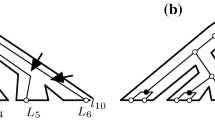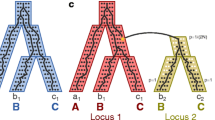Abstract
Phylogenetic tree reconciliation is a widely-used method to understand gene family evolution. For eukaryotes, the duplication-loss-coalescence (DLC) model seeks to explain incongruence between gene trees and species trees by postulating gene duplication, gene loss, and deep coalescence events. While efficient algorithms exist for inferring optimal DLC reconciliations, they assume that only one individual is sampled per species. In recent work, we demonstrated that with additional samples, there exist gene tree topologies that are impossible to reconcile with any species tree. However, our algorithm required the gene tree to be binary whereas, in practice, gene trees are often non-binary due to uncertainty in the reconstruction process. In this work, we consider for the first time reconciliation under the DLC model with non-binary gene trees. Specifically, we describe an efficient algorithm that takes as input an arbitrary gene tree with an arbitrary number of samples per species and either (1) determines that there is a valid reconcilable binary resolution of that tree and constructs one such resolution or (2) determines that there exists no valid reconcilable binary resolution of that tree. Our work makes it possible to systematically analyze non-binary gene trees and will help biologists identify incorrect gene tree topologies and thus avoid incorrect evolutionary inferences.
M. Dohlen and C. Pekker—These authors contributed equally to this work.
Access this chapter
Tax calculation will be finalised at checkout
Purchases are for personal use only
Similar content being viewed by others
Notes
- 1.
Branch lengths are not used in this work, so a tree always refers to a tree topology.
- 2.
The proof considers only the single unique path between two genes in a binary tree.
- 3.
Note that this locus tree is distinct from the locus tree of Rasmussen and Kellis [25].
- 4.
For example, in Fig. 3, swapping leaves labeled \(a_2\) with leaves labeled \(c_1\) would result in an irreconcilable LEG and thus a multifurcating gene tree for which there exists no reconcilable binarization.
- 5.
While most reconciliation algorithms do not support multiple samples per species nor non-binary gene trees, the former extension is fairly straightforward while the latter requires new algorithms.
References
Åkerborg, Ö., Sennblad, B., Arvestad, L., Lagergren, J.: Simultaneous Bayesian gene tree reconstruction and reconciliation analysis. Proc. Nat. Acad. Sci. USA 106(14), 5714–5719 (2009)
Albalat, R., Cañestro, C.: Evolution by gene loss. Nat. Rev. Genet. 17, 379 (2016)
Bansal, M.S., Alm, E.J., Kellis, M.: Efficient algorithms for the reconciliation problem with gene duplication, horizontal transfer and loss. Bioinformatics 28(12), i283–i291 (2012)
Burleigh, J.G., Bansal, M.S., Eulenstein, O., Hartmann, S., Wehe, A., Vision, T.J.: Genome-scale phylogenetics: inferring the plant tree of life from 18,896 gene trees. Syst. Biol. 60(2), 117–125 (2011)
Chang, W.-C., Eulenstein, O.: Reconciling gene trees with apparent polytomies. In: Chen, D.Z., Lee, D.T. (eds.) COCOON 2006. LNCS, vol. 4112, pp. 235–244. Springer, Heidelberg (2006). https://doi.org/10.1007/11809678_26
Chauve, C., Doyon, J.P., El-Mabrouk, N.: Gene family evolution by duplication, speciation, and loss. J. Comput. Biol. 15(8), 1043–1062 (2008)
Chen, K., Durand, D., Farach-Colton, M.: NOTUNG: a program for dating gene duplications and optimizing gene family trees. J. Comput. Biol. 7(3–4), 429–447 (2000)
Chen, Z.Z., Deng, F., Wang, L.: Simultaneous identification of duplications, losses, and lateral gene transfers. IEEE/ACM Trans. Comput. Biol. Bioinform. 9(5), 1515–1528 (2012)
Conow, C., Fielder, D., Ovadia, Y., Libeskind-Hadas, R.: Jane: a new tool for the cophylogeny reconstruction problem. Algorithm. Mol. Biol. 5(16) (2010). https://almob.biomedcentral.com/articles/10.1186/1748-7188-5-16
David, L.A., Alm, E.J.: Rapid evolutionary innovation during an archaean genetic expansion. Nature 469(7328), 93–96 (2011)
Degnan, J.H., Rosenberg, N.A.: Gene tree discordance, phylogenetic inference and the multispecies coalescent. Trends Ecol. Evol. 24(6), 332–340 (2009)
Delsuc, F., Brinkmann, H., Philippe, H.: Phylogenomics and the reconstruction of the tree of life. Nat. Rev. Genet. 6(5), 361–375 (2005)
Doyon, J.-P., Scornavacca, C., Gorbunov, K.Y., Szöllősi, G.J., Ranwez, V., Berry, V.: An efficient algorithm for gene/species trees parsimonious reconciliation with losses, duplications and transfers. In: Tannier, E. (ed.) RECOMB-CG 2010. LNCS, vol. 6398, pp. 93–108. Springer, Heidelberg (2010). https://doi.org/10.1007/978-3-642-16181-0_9
Goodman, M., Czelusniak, J., Moore, G.W., Romero-Herrera, A., Matsuda, G.: Fitting the gene lineage into its species lineage, a parsimony strategy illustrated by cladograms constructed from globin sequences. Syst. Zool. 28(2), 132–163 (1979)
Górecki, P., Tiuryn, J.: Dls-trees: a model of evolutionary scenarios. Theor. Comput. Sci. 359(1–3), 378–399 (2006)
Koonin, E.V.: Orthologs, paralogs, and evolutionary genomics. Annu. Rev. Genet. 39(1), 309–338 (2005)
Kordi, M., Bansal, M.S.: Exact algorithms for duplication-transfer-loss reconciliation with non-binary gene trees. IEEE/ACM Trans. Comput. Biol. Bioinform. PP(99), 1 (2018)
Lafond, M., Swenson, K.M., El-Mabrouk, N.: An optimal reconciliation algorithm for gene trees with polytomies. In: Raphael, B., Tang, J. (eds.) WABI 2012. LNCS, vol. 7534, pp. 106–122. Springer, Heidelberg (2012). https://doi.org/10.1007/978-3-642-33122-0_9
Maddison, W.P.: Gene trees in species trees. Syst. Biol. 46(3), 523–536 (1997)
Ochman, H.: Lateral and oblique gene transfer. Curr. Opin. Genet. Dev. 11(6), 616–619 (2001)
Ohno, S.: Evolution by Gene Duplication. Springer, Heidelberg (1970). https://doi.org/10.1007/978-3-642-86659-3
Page, R.D.: Maps between trees and cladistic analysis of historical associations among genes, organisms, and areas. Syst. Biol. 43(1), 58–77 (1994)
Rannala, B., Yang, Z.: Bayes estimation of species divergence times and ancestral population sizes using DNA sequences from multiple loci. Genetics 164(4), 1645–1656 (2003)
Rasmussen, M.D., Kellis, M.: A Bayesian approach for fast and accurate gene tree reconstruction. Mol. Biol. Evol. 28(1), 273–290 (2011)
Rasmussen, M.D., Kellis, M.: Unified modeling of gene duplication, loss, and coalescence using a locus tree. Genome. Res. 22, 755–765 (2012)
Rogers, J., Fishberg, A., Youngs, N., Wu, Y.C.: Reconciliation feasibility in the presence of gene duplication, loss, and coalescence with multiple individuals per species. BMC Bioinform. 18, 292 (2017)
Slowinski, J.B.: Molecular polytomies. Mol. Phylogenet. Evol. 19(1), 114–120 (2001)
Stamatakis, A.: RAxML-VI-HPC: maximum likelihood-based phylogenetic analyses with thousands of taxa and mixed models. Bioinformatics 22(21), 2688–2690 (2006)
Tofigh, A., Hallett, M., Lagergren, J.: Simultaneous identification of duplications and lateral gene transfers. IEEE/ACM Trans. Comput. Biol. Bioinform. 8(2), 517–535 (2011)
Vilella, A.J., Severin, J., Ureta-Vidal, A., Heng, L., Durbin, R., Birney, E.: Ensemblcompara genetrees: complete, duplication-aware phylogenetic trees in vertebrates. Genome. Res. 19(2), 327–335 (2009)
Wu, T., Zhang, L.: Structural properties of the reconciliation space and their applications in enumerating nearly-optimal reconciliations between a gene tree and a species tree. BMC Bioinform. 12(Suppl 9), S7 (2011)
Wu, Y.C., Rasmussen, M.D., Bansal, M.S., Kellis, M.: Most parsimonious reconciliation in the presence of gene duplication, loss, and deep coalescence using labeled coalescent trees. Genome Res. 24(3), 475–486 (2014)
Zhang, L.: From gene trees to species trees ii: species tree inference by minimizing deep coalescence events. IEEE/ACM Trans. Comput. Biol. Bioinform. 8(6), 1685–1691 (2011)
Zheng, Y., Zhang, L.: Reconciliation with non-binary Gene trees revisited. In: Sharan, R. (ed.) RECOMB 2014. LNCS, vol. 8394, pp. 418–432. Springer, Cham (2014). https://doi.org/10.1007/978-3-319-05269-4_33
Zmasek, C.M., Eddy, S.R.: A simple algorithm to infer gene duplication and speciation events on a gene tree. Bioinformatics 17(9), 821–828 (2001)
Acknowledgments
This work was supported by funds from the Department of Computer Science and the Dean of Faculty of Harvey Mudd College and by the U.S. National Science Foundation under grant IIS-1419739.
Author information
Authors and Affiliations
Corresponding author
Editor information
Editors and Affiliations
Rights and permissions
Copyright information
© 2018 Springer International Publishing AG, part of Springer Nature
About this paper
Cite this paper
Cheng, R. et al. (2018). Reconciliation Feasibility of Non-binary Gene Trees Under a Duplication-Loss-Coalescence Model. In: Jansson, J., Martín-Vide, C., Vega-Rodríguez, M. (eds) Algorithms for Computational Biology. AlCoB 2018. Lecture Notes in Computer Science(), vol 10849. Springer, Cham. https://doi.org/10.1007/978-3-319-91938-6_2
Download citation
DOI: https://doi.org/10.1007/978-3-319-91938-6_2
Published:
Publisher Name: Springer, Cham
Print ISBN: 978-3-319-91937-9
Online ISBN: 978-3-319-91938-6
eBook Packages: Computer ScienceComputer Science (R0)




